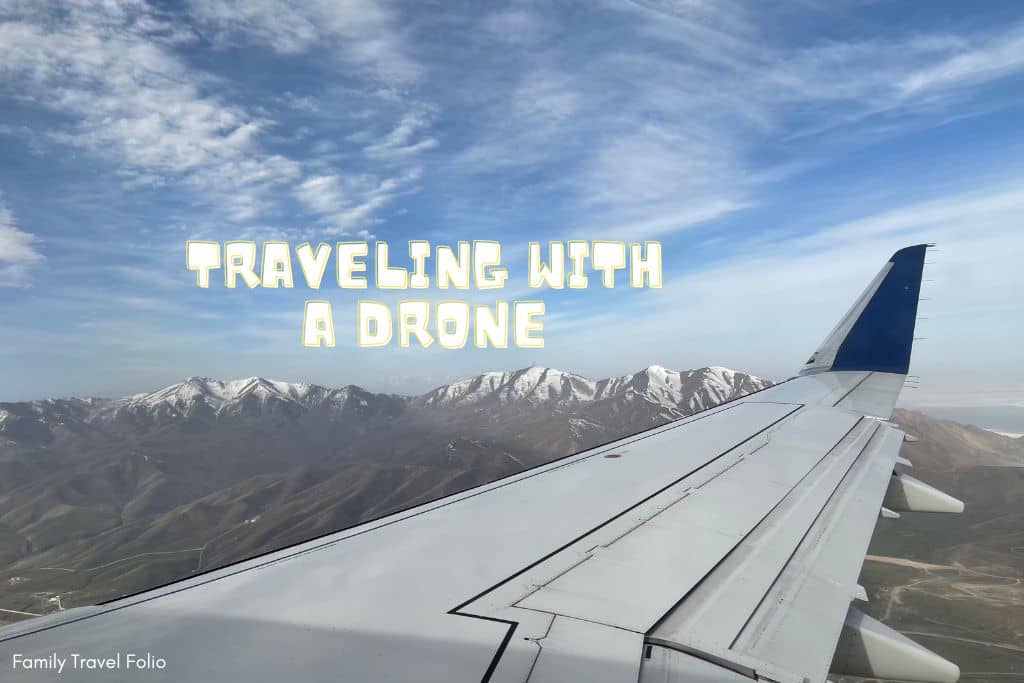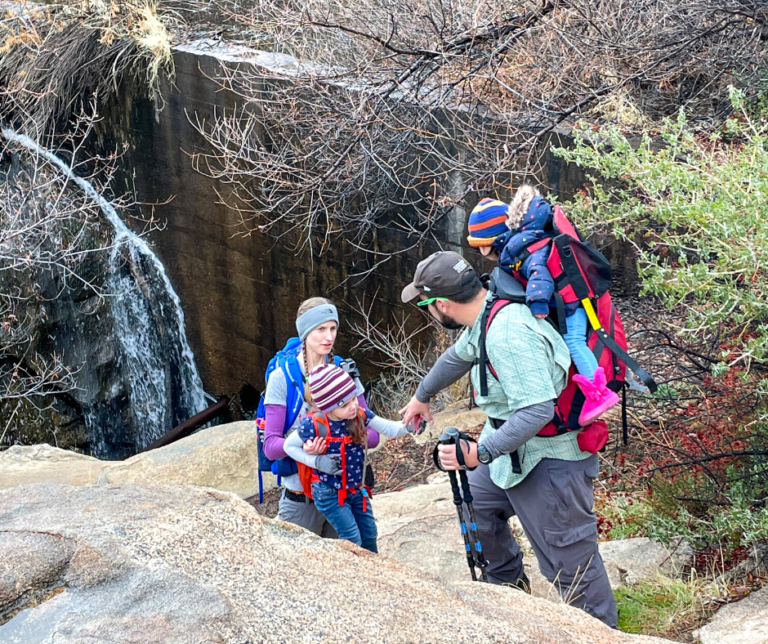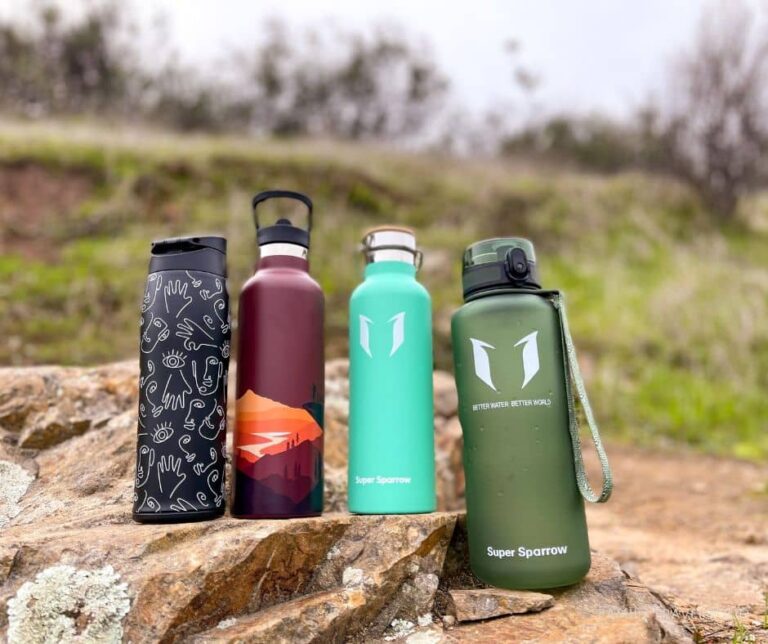Everything You Need To Know About Traveling With A Drone
Traveling with a drone can cause a lot of headaches if you don’t know the regulations and airline policies., but using a drone for aerial video footage is exciting and captures memories from a whole new perspective.
So what do you do?
We recently got a drone because my husband loves to fly drones and I like the extra bird’s eye view for our memories and my blog content. There were way more drone rules I didn’t even know about, like where you can’t fly a drone, TSA requirements, and drone licensing and certification.
Each country you’re traveling to has different rules on where drones are allowed and there are airline restrictions on batteries.
This ultimate guide to bringing your drone with you traveling covers everything you’ll need to know about drone use on vacation.
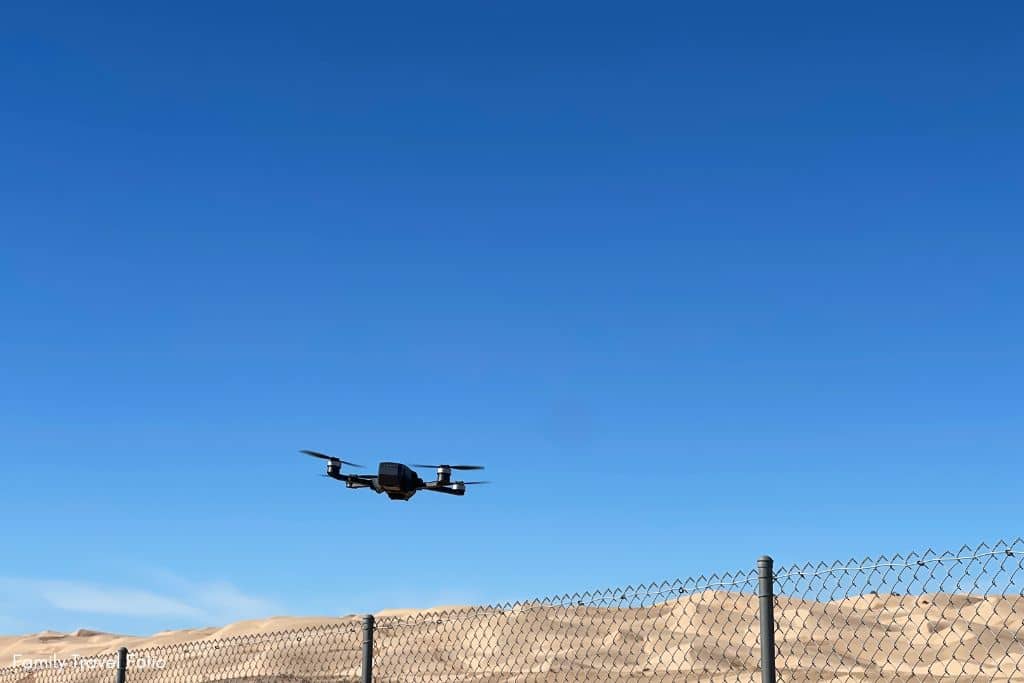

Understanding Drone Travel Regulations
Researching Drone Laws by Country
When you’re planning to travel with a drone, established drone laws vary from one country to another. These laws are divided into recreational and commercial use categories, and they can range from entirely unrestricted to highly regulated.
The Drone Laws World Map, by DroneMade, color-codes countries based on their drone regulations: green for countries with minimal restrictions, yellow for those requiring paperwork or permissions, and red for places where drone flying is heavily restricted or banned. It’s an easy and quick way to check where you can fly your drone.
Some countries may have full bans on drones for various reasons, like security concerns, wildlife protection, or a lack of established guidelines. Countries like Algeria, Egypt, and Iran have specific bans or extra restrictions on the use of drones. Places like India allow lightweight nano drones under 250 grams to be used in authorized zones with heavier drones requiring permission.
In the United States, Drone use is banned in all National Parks, but State Park rules can vary. A general rule of thumb is you can not bring drones into wildlife protection areas.
You’ll want to check the destination country’s Civil Aviation Authority (CAA) website for the most current regulations to avoid issues like having your drone confiscated.
(Image Source: drone-laws)
Guide to Bringing a Drone on an Airplane
Prior to traveling with your drone, check with your airline on their drone rules. The Transportation Security Administration (TSA) allows drones through checkpoints, but the final decision comes down to the TSA officer on duty.
A common airline concern is the transportation of lithium-ion batteries in cargo compartments, so you may not be able to have your drone in checked baggage.
Disconnect the drone’s battery to prevent accidental activation during the flight. You can protect your drone from damage by storing it in a specialized camera or drone case.
Before traveling with a drone, do a test flight at home to make sure your drone is functioning correctly. This will make it easier to troubleshoot if it gets pushed around while packed in a carry-on.
You need to register the drone with the Federal Aviation Administration (FAA) if it weighs more than 250 grams.
Drone No-Fly Zones and Privacy Concerns
Respecting no-fly zones is your responsibility. The manufacturer’s website provides a process to submit an unlock request for no-fly zones for DJI drones, but it’s nice to have that automatic lock if you get close to one of these zones.
In the United States, the FAA UAS Facility Map shows where drones can be flown. The green grids are areas where instant authorization is available and red grids highlight zones where special waivers are required. So if you need to fly drones above the listed maximum altitude an Airspace Waiver has to be filed through the FAA DroneZone website.
As a drone pilot, you need to respect privacy concerns and local no-fly rules, like those at resorts or conservation areas. Flying in national parks, wildlife preserves, and other protected areas is typically prohibited to avoid disturbing wildlife.
Even in zones where we can fly our drone, we’ve had angry birds fly at “Dronella Flower.” Yes, we named our drone, and yes it was named by 2 little girls.
Good drone etiquette goes a long way, just like being respectful of other hikers or campers. Don’t intrude on other’s space and don’t film anyone without permission.
Extreme weather can have a big impact on battery life and performance. We try and avoid flying the drone in windy conditions so we can maintain control and not lose the drone to a random gust of wind. Carry backup memory cards and extra batteries.
Some countries may require you to have liability insurance if you’re flying a drone, so check these requirements before traveling.
Preparing Your Drone for Travel
Packing Tips for Drones and Accessories
Deactivate your drone and safeguard any switches to avoid it accidentally turning on while flying on a plane.
We returned one drone because there was an issue with a propeller. I’m kind of glad that happened because it didn’t have a case to store it. When researching what new drone to buy, we bought one with a carrying case for better protection when packed in a carry-on or even just in the car.
Some airlines say drones are prohibited in baggage and require drones to be stored in a carry-on while other airlines are a bit more flexible. If the rules need to be clarified, contact the airline directly for guidance.
Battery Safety and Storage Protocols
FAA hazardous materials regulations govern LiPo batteries, and they must be transported in carry-on luggage. You can pack your batteries using original retail packaging, insulate the terminals with tape, use a battery case or sleeve, or place them in a plastic bag or protective pouch. Isolate each battery to prevent contact with conductive materials or other batteries.
For batteries over 100 Watt Hours (Wh), you have to get airline approval for a carry-on bag with them onboard, and there is usually a limit of two spare batteries of this size. Batteries of 100 Wh or less are permitted in checked luggage only if they are installed in the equipment. Spare batteries are not permitted in checked luggage.
Firmware Updates and Pre-Travel Checks
Update your drone’s firmware before your trip to make sure you have any recent updates and that it’s functioning properly. Fully charge your drone’s battery, but know temperature changes while traveling can affect battery performance. High temperatures can cause batteries to swell, which is not a hazard.
Check your memory cards for compatibility with your drone’s camera to make sure you’re good on file sizes and recording speeds.
Best Practices for Flying Drones Abroad
Understanding Local Etiquette and Permissions
It’s crucial to stay informed about the drone regulations and updates in the country you plan to visit. The drone industry is growing fast, so nations frequently update their policies. These changes in current rules can be very different for recreational versus commercial purposes.
In the US, registration with the FAA and pilot certification are required. The EU has established a framework for drone licensing with three operational categories, each with specific training and certification prerequisites.
Each country should have resources available for legally taking your drone within their borders. Common restrictions include ceiling limits for drone flights and prohibitions on flying over individuals or large gatherings.
Flying near airports typically requires prior approval from air traffic control, and can be restricted to time frames of good weather and daylight.
Maximizing Flight Time and Battery Life
To extend your drone flight time, make sure your batteries are fully charged and in good condition before each use.
Plan your drone’s flights to conserve battery life such as avoiding poor weather and protecting your batteries from extreme temperatures. When not in use, store the drone and the batteries correctly, and consider carrying extra batteries.
Not everywhere will have convenient electricity to charge your drone’s batteries or network connection to upload video files from the memory cards to your laptop or tablet.
Aerial Photography and Videography Tips
If you want to capture aerial footage, follow the host country’s regulations. Let people know before filming in their vicinity and avoid unauthorized flights over private property. Be aware of restricted areas, including government facilities and conservation zones.
When capturing high-quality images and videos, consider the lighting conditions. The golden hours of dawn and dusk are usually the best for photography because of the natural lighting. Practice with your drone’s camera options and plan your shots ahead of time.
Whenever I film content, it always turns out best if I have an idea in my head about what type of footage I’m looking for. Planning also makes sure I don’t forget to film an angle I want to get.
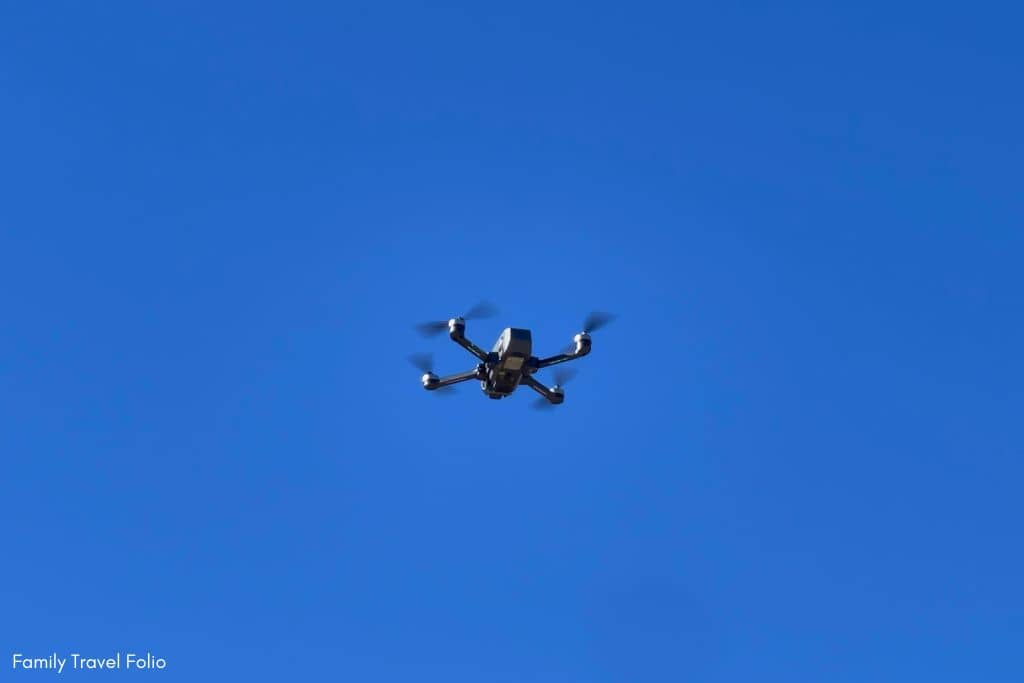

Dealing with Common Drone Travel Issues
Troubleshooting Drone Functionality on the Go
Magnetic interference is a potential problem that can disrupt your drone. To avoid this as much as possible, operate your drone away from areas with high magnetic activity, like large metal structures or industrial zones.
If you receive a magnetic interference alert, take it seriously and change your flight path. Always maintain visual contact with your drone and be prepared to switch to manual control if necessary.
Your drone can think cold temperatures mean a low battery level, which could lead to an unexpected power-down. Keep your drone batteries insulated against the cold and have spares. For minor accidents or technical issues, bring a repair kit with essential tools and spare parts.
Navigating Customs and Security with a Drone
Follow airline regulations for carrying batteries. Just assume you will transport them in your carry-on luggage in a fireproof bag. At security checkpoints, separate the batteries from your drone and place them in a tray to help with the screening process. Covering the battery contacts with tape can help prevent short circuits.
Be aware of the limits on battery capacity. For those between 101 and 160 Wh, you may be limited to two per passenger. Confirm their requirements with your airline and consult the TSA and FAA for the latest travel guidance with batteries and portable electronic devices.
Clear communication during customs inspections can make everything easier. Be ready to present your drone, its batteries, and all relevant paperwork to officials, like any insurance or operating permits.
Insuring Your Drone for International Travel
Insurance for your drone can help against potential damages during your travels. I’m not saying you’ll crash your drone, but you never know what might happen. When checking in your drone on a plane, place it in a sturdy container to protect it.
Before international trips, get familiar with your destination country’s drone laws and aerial regulations. Get the necessary permits ahead of time for a trouble-free experience with your drone.
Capturing and Sharing Your Drone Footage
Drone footage offers a unique perspective. It’s becoming more and more popular not just for movies, but for social media platforms. Even if I wasn’t a content creator, I would love to add videos and photos from up above to capture more amazing family vacation memories. We even took drone photos of my parents’ house at Christmas to capture my dad’s amazing Christmas light display.
Editing Software Choices for Travelers
You’ll need multiple editing techniques to elevate your drone footage to a more professional level. These include cutting clips, adding music, adjusting colors, applying filters, adding transitions, altering speed, stabilizing shaky footage, and cropping videos for the perfect frame.
VideoProc Vlogger is a user-friendly, professional editing tool for beginners and intermediate users. Its official channel even offers tips to make your drone footage more cinematic.
For Mac users, Final Cut Pro is a great option. I used Final Cut Pro in my high school social media class. I didn’t like using a Mac, but the editing software was great. Another option is iMovie which has a convenient built-in editor for iOS and Mac users.
Windows users can use VSDC Free Video Editor which is a lightweight choice. Windows Movie Maker is a popular option, but not the best since it doesn’t have updates anymore. Adobe Premiere Pro offers a full suite of features for you if you have more advanced editing knowledge. DaVinci Resolve is available on Windows, Mac, and Linux.
I use PowerDirector on my PC desktop and love it. For my iPhone, I use a free version of VLLO. It doesn’t have a lot of editing options with the free version, but it gets the job done and keeps the video quality.
There are tons of software options, so find one that fits your editing needs and skill levels and stick with it.
Storing and Backing Up Aerial Content
When capturing high-resolution 4K video, storage space is a concern. On-the-go backup solutions are extremely important. You can geta device that copies content from an SD card to a Cloud service. Or you can transfer files directly to a tablet or laptop with onboard storage and an external hard drive.
You can use your smartphone as temporary storage, transferring files from the drone directly to the phone, but then you still have the concern of your phone running out of storage space. Portable hard drives or solid-state drives (SSDs) are standard tools to help with this. I need to get better at uploading my videos and photos way more often.
Don’t forget to pack spare SD memory cards!
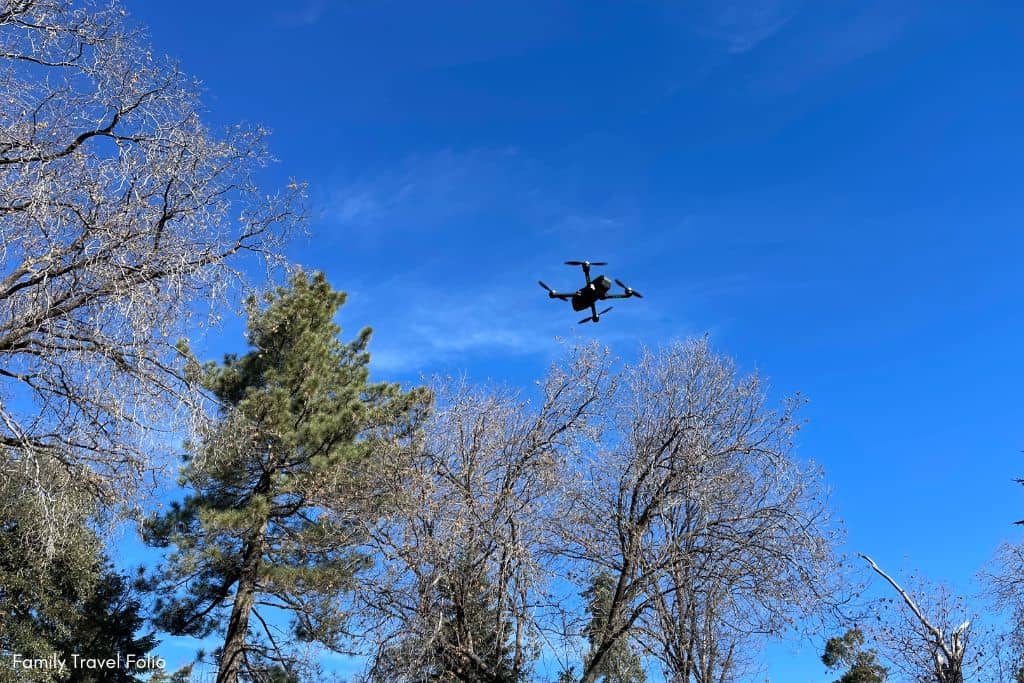

Legal Considerations for Publishing Drone Footage
Before sharing drone footage, know the legal landscape regulations regarding drone flight and photography.
In the United States, drone photographs and videos are automatically protected by copyright law, with registration recommended for valuable works. As the copyright owner you have the right to authorize how your content is used.
This becomes more difficult when multiple parties are involved, such as if one person flies the drone while another operates the camera. This isn’t too much of a concern if you’re not posting the footage, but even if you’re not a content creator you want to make sure you have proper permissions. Make sure you have a clear agreement to assign copyright ownership and waiver of content rights.
Copyright infringement carries significant penalties, so you’ll want to ensure proper licensing and protection of your drone footage.
Drone service companies navigate between copyright law and daily operations, including employee relationships and licensing agreements.
Drone operation comes with its own set of regulations. The FAA Remote Identification Rule, which began on September 16, 2023, mandates drones to transmit identifying information about the drone and its operator.
This rule will require newer drones to have a built-in broadcast utility. At the same time, older models may need an accessory module to comply.
You need to follow the FAA’s Part 107 Small UAS Rule for commercial usage, such as real estate photography. Realtors must also check that any third-party drone service providers have proper insurance, a current pilot certificate, and a clear understanding of the legal implications of drone operation, including indemnification for claims related to privacy, personal injury, and property damage.
These precautions help with the risks associated with drone malfunctions and crashes, which can lead to property damage or personal injury.
I know it seems like a lot for just recording your family vacation memories, but it’s good to be aware of the details out there about using drones.
Summary of Traveling with a Drone
Traveling with a drone opens the door to more exploration and creativity.
As long as you check drone laws for your destination and air travel, your trip should go smoothly. It’s also important to take good care of your drone by having the proper battery support, memory card backup, and protective casing.
Drone rules will continue to change and update. It is your responsibility to make sure you are complying with all drone laws wherever you go.
So charge up, pack smart, bring your drone, and have an amazing trip!

